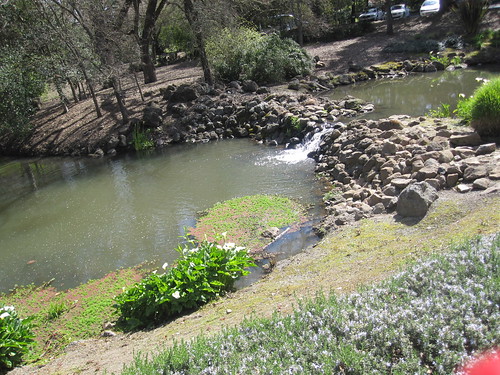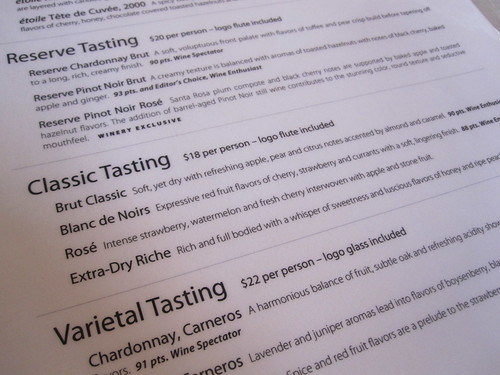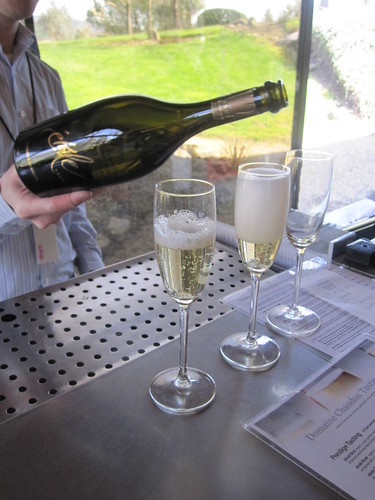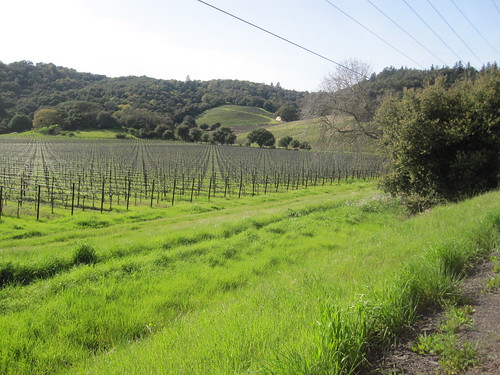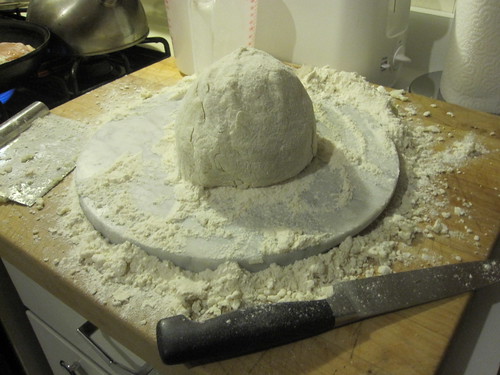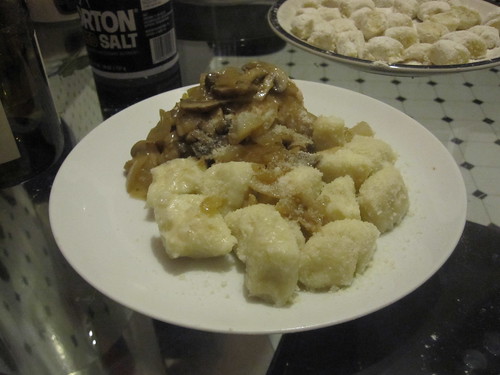Show of hands, who knows much about Filipino food? Besides natives of the Philippines, I don't know how many of the rest of us seek out Filipino food on a regular basis, or even know exactly where to find it. A quick search reveals that are only a handful of restaurants in the greater NYC area, and even fewer make it onto the city guides' radars. For example, the Zagat 2010 NYC Restaurants guide only lists two, one in Manhattan and one in Clinton Hill.
Luckily, ethnic communities have spread to the various boroughs, leading to the development of dining blocks that have lured many a food seeker. One such find is
Tito Rad's in Queens, where I, along with nine other food adventurers, had the fortune to attend dinner with our Filipino
Food Ambassador,
Stella, who guided us through the various aspects of Filipino cuisine.
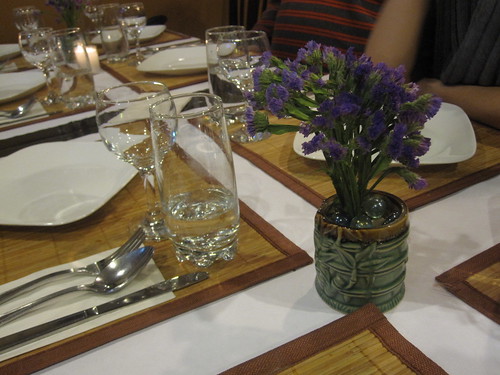
On a rainy Tuesday evening, ten of us gathered at Tito Rad's to explore Filipino food by the best method: tasting our way through as much of the menu as was humanly possible. At least, that's what I identified the common underlying goal to be, as the plates just kept on coming.
Stella had already ordered by the time I arrived, and was rushing out to fulfill the restaurant's BYOB option. During that time, Franny arrived bearing a bottle of Chardonnay for the group. We were just opening it up when Stella came back victorious with two six-packs of Heineken. After going through the meal and pairing the food with different beverages, some of the dishes can be constituted as "bar food", easily downed with a swig of beer. Since Filipino food is an eclectic mix of diverse ethnic influences, and our group was composed of various backgrounds, it seems appropriate that every element reflected the diversity of the cuisine.
So with our beverage supplies in no shortage, the flow of food began.

We began with a familiar looking dish, a pork spring roll with a sweet chili dipping sauce on the side. If you guessed that these bore a striking resemblance to Chinese spring rolls, you'd be right.
Lumpiang Shanghai, as evidenced by the name, highlights the Chinese influence in Filipino food which still remains strong. Crispy, fried, and a slightly heavier version than the Chinese version that I'm accustomed to, I imagine these work great as finger food with a beer in hand.

Another starter was the
Chicharon Bulaklak. At first we called it fried pork rinds, but Stella explained it as the "pig muscle that holds together the intestines", although nobody really knows what that part is called.
Chicharon in Filipino eating terms is "deep fried crunchified anything", though the word is an indicator of Spanish influence.
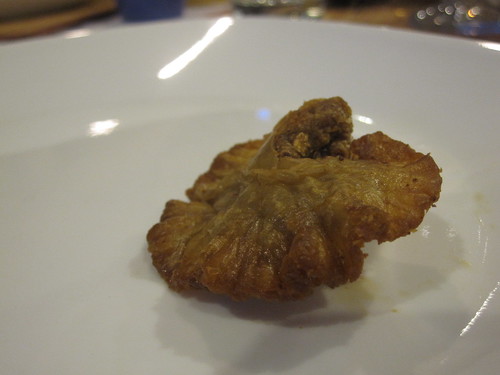
The second part of the name is poetic, as the word "bulaklak" is Tagalog for "flower". Each individual piece splayed out in a pretty little shape. Not to mention, this was another dish that pairs well with beer.
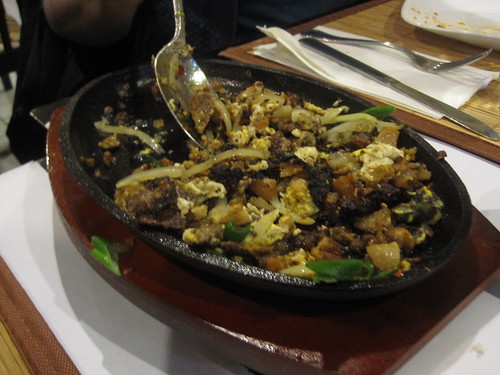
Consisting of boiled, grilled, and chopped up pork snout, ears, liver, and the additional eggs in this version,
Sisig is the Filipino claim to snout-to-tail before it became all the rage here in the States.
Sisig is the most popular, typical bar snack to pair with a beer. Clearly, the Heineken had earned their place at the dinner table.
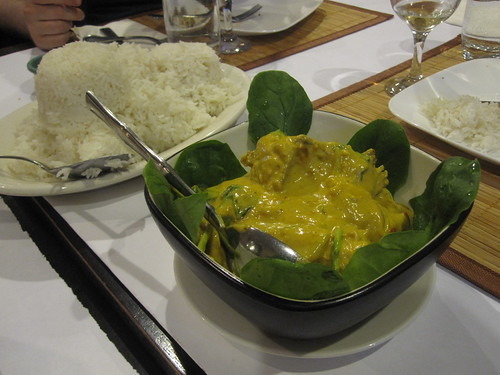
Next we moved onto pinpointing the Muslim influence with this hearty
Chicken Curry, which isn't exactly that common in traditional Filipino cuisine. In fact, this was the only curry on the menu. The preparation wasn't mind-blowingly unique, but nevertheless delicious, especially when eaten with the funny boat-shaped mound of rice in the back.

Now we're talking! Although it might not look like anything distinctive,
Spicy Laing is made of taro leaves stewed in coconut milk. I couldn't really taste the spiciness in the dish, but I have no gripes about that. It had the creaminess and addictive power of a dip, with the added bonus of having taro leaves to help those of us who wanted to pretend it was healthier. Kind of like how artichoke and spinach dips are a good way to get in your daily dose of vitamins. Right, just like that. Moving on.
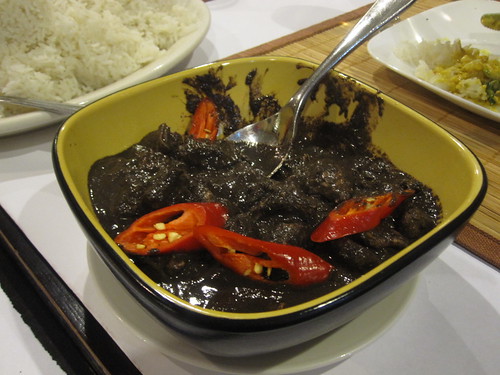
Some people might have heard of
Dinuguan, or pigs blood stew, if only for the potential gross-out factor that's not really that disturbing once you taste it. I wasn't aware of what it was at the time, besides thinking "hm, this has a pretty strong flavor, but the meat is a little dry".

Regrettably, I didn't snap a better photo of the
Abodong Baboy because it went pretty quickly. Understandably so, since this juicy pork/chicken was braised in a mixture of soy sauce, vinegar, and a little garlic that lent a strong flavor and impact to the final dish.
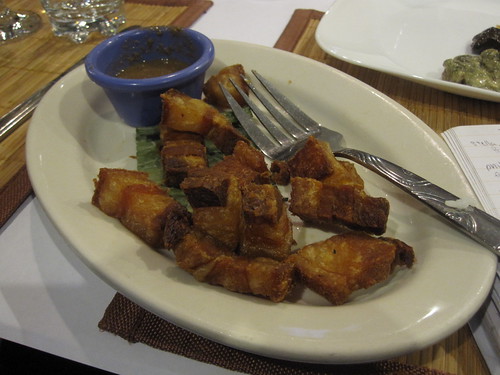
The
Lechon Kawali appeared on the table sometime between the appetizers and the bigger entrees. It's basically fried pork belly with a sugary glaze. I'm already a big fan of pork belly, and I'm not going to argue with breaking out the deep fryer. It wasn't very greasy or heavy, and the fried aspect was more to add crisp and texture dimension than it was to distract the eater from being aware of what they're eating.
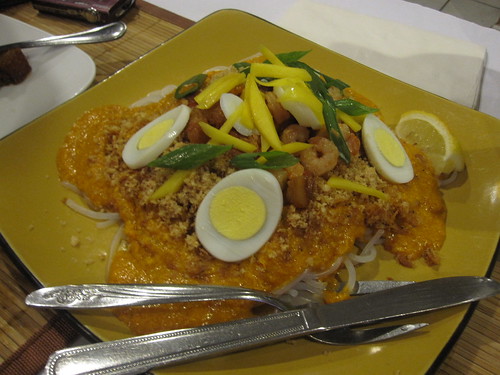
Then we moved on to noodles, or
Pansit. This generously portioned one is called
Palabok, with boiled eggs, shrimp, and good ol' chicharones on top of glass noodles. I heard some murmurs about it being too bland, but it was a nice accompaniment to the other bolder flavored dishes being passed around the table.
 Bam-i
Bam-i is an interesting visayan pancit using a combination of both egg and glass noodles, whereas usually just one type is used. Mixed with snap peas and carrots, it reminded me of a similar preparation style in Chinese cuisine.
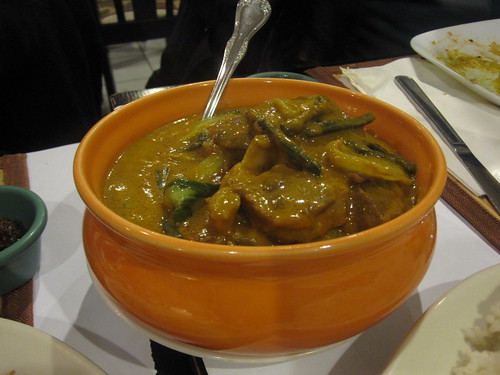
Another great Filipino dish to try if you've never had it before.
Kare Kare is not for people who shy away from heavy sauces or comfort food. This bowl holds ox tail in a peanut-based soup with bits of bok choy, meant to be eaten with bagoong alamang (shrimp paste).
 Tortang Dilis
Tortang Dilis might not seem at first to be anything more than a speckled puff ball, but it's actually an omelette with
dulong, tiny silver fish otherwise known as baby anchovies. The minuscule fish are used throughout Asian cooking, since my mom made a similar version with a flour batter, and similarly served with ketchup as a dipping sauce. Hey, influences stick!
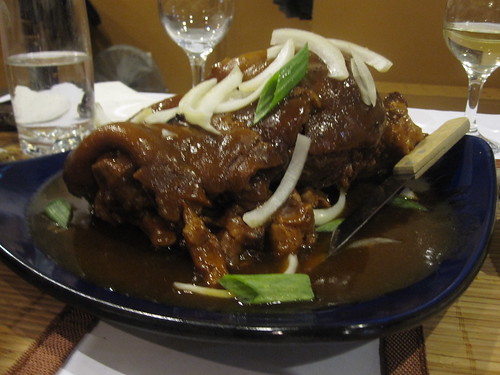
Oh,
Humba. You make me so happy when you arrive at the end of the meal, steaming hot and falling off the bones tender. Braised pork knuckle might induce more food euphoria than this gal can handle, so luckily there were nine other people to help take the burden off my stomach. It is slightly sweeter than the Chinese version, though the larger scale produced bigger, fattier, and softer pieces of meat.
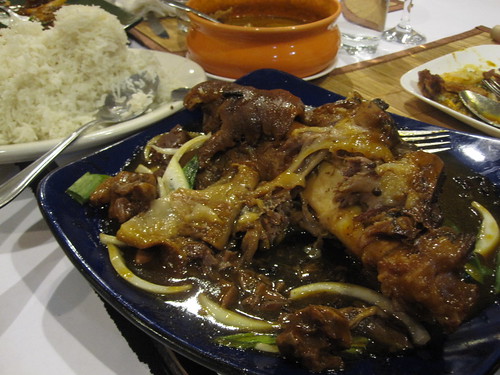
The aftermath. I kid you not when I say I could probably eat an entire portion myself, and I had to limit myself to
only three helpings.
Time for my favorite part of the meal, DESSERT!

So technically, this isn't dessert. Stella explained that
Turon is eaten as more of a midday, tea-time snack. It's sweet plantains with jackfruit inside eggroll wrappers, fried, and covered with sticky brown sugar. We couldn't really taste the jackfruit, but the scoop of vanilla ice cream on the side was a nice additional sugar boost. Because clearly, all of the above couldn't possibly be sweet enough.
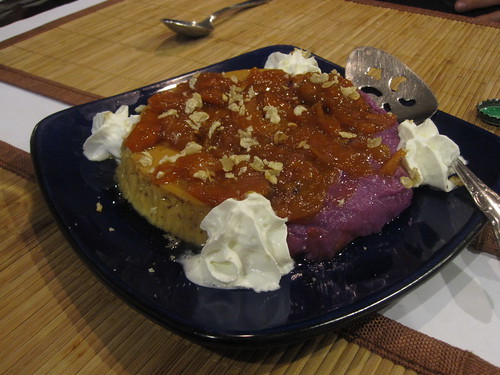
This was our primary dessert, or actually, it was more of a half and half split between two desserts since we were relatively full. Half was a dense, creamy
Leche Flan, and the other was
Ube Halaya. Ube, or purple yam, a popular ingredient in Filipino cooking, is not to be confused with Taro, a root vegetable used more in Chinese cuisines and has a much less vibrant purple color and a milder taste.
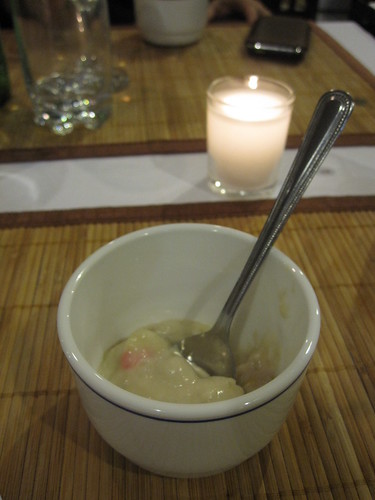
Finally, we all got a personal cup of
Ginataan, the main component of which is coconut milk ("gata"). An array of add-ins, including sweet plantains, potatoes, taro, and sago are cooked in coconut milk to produce a thick, dense dessert that wasn't actually all that sweet. I think we were thankful for the tasting portion size after all of the other food we somehow polished off.
The night ended amicably with a mass photo session of all of us with the store owners. Stella lightheartedly exclaimed that Filipino people love to take photos, and well, who are we to argue with popular culture?
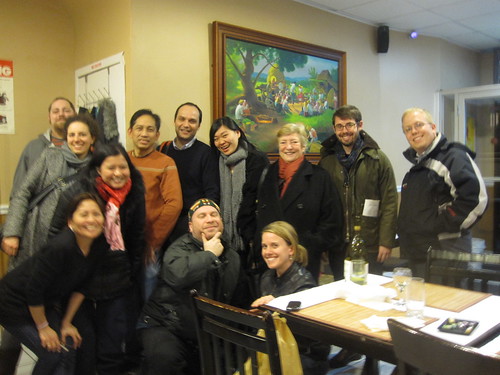
One big, happy, eating family! Even the store owners got some of their own cameras in there. We inadvertently stayed after closing hours, but they were quick and accommodating throughout the entire meal. The restaurant itself is in an intimate, unimposing space, with that certain warmth-of-home feel which makes ethnic hole-in-the-walls so satisfying. The final bill ended up being around $20 a head, and was reasonable considering how much food we ordered. I asked our food ambassador Stella why she chose Tito Rad's to host the dinner, and what she knew about the owners' backgrounds. This is what she had to say:
"I chose them because their food has always been consistent tasting and not greasy. Also, it feels more home made to me than the ones by 69th street and Woodside. I know they are from Cebu, the island discovered by Ferdinand Magellan. Their dialect is one that I can understand about half the time, but my siblings and I only grew up speaking Tagalog (and English for school) [..] another thing, the other restaurants have more tables and are more popular - it was just lucky that we came to Tito Rad's on a night that they weren't full and they gave us all their attention."
In the end, while most of the locals in our group walked off the meal, I split up and trekked back to Manhattan with a full belly and plenty of food for thought. Admittedly, most of that thought was what I would order the next time I return. Who's up for trying the rest of the menu?
Thanks to Stella for her constructive feedback in filling in gaps in my notes afterward, and to my fellow diners for being loads of fun to dine with. You can find more photos from the dinner with additional dishes and comments here.

